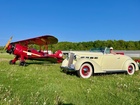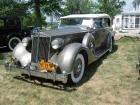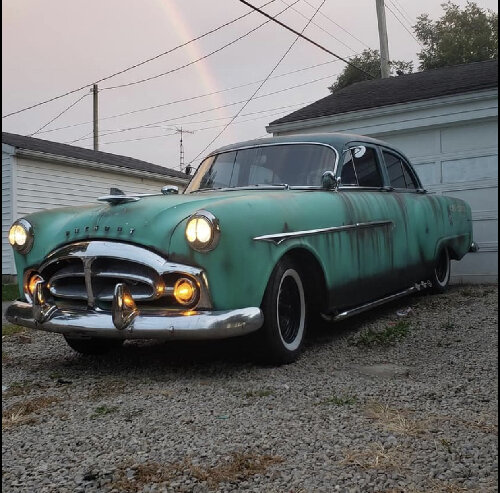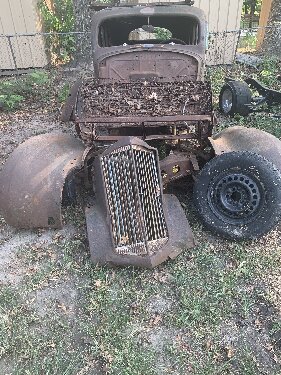|
Re: Survival rates of pre-war cars
|
||||
|---|---|---|---|---|
|
Home away from home

|
Quote:
"1953 television ad, "53% of all Packards ever built since way back 1899 are still in use. Built like a Packard means built to last." Hmmmmm. well lets see here. We know a 'half life' (53% rounded to 50%) of packard production is 50 years (rounded) then we ought to be able to compute a table for any given time t containing survivor population. Or to put it another way, treat the survivors like the half-life of any other substance involving the natural logarithim e**x. Be interesting to see how close it comes to Kev's chart and some of the other ideas on survivor numbers. t = time in number of years since production started. S = # of survivors at t years. k = constant to be computed. I hope i remeber this rite: dS/dt = kS I'll have to work on it tomorrow.
Posted on: 2011/1/11 23:26
|
|||
|
VAPOR LOCK demystified: See paragraph SEVEN of PMCC documentaion as listed in post #11 of the following thread:f
https://packardinfo.com/xoops/html/modules/newbb/viewtopic.php?topic_id=7245 |
||||
|
||||
|
Re: Survival rates of pre-war cars
|
||||
|---|---|---|---|---|
|
Home away from home
|
your equation for first order exponential decay is right , but the problem lies in the assumption that the decay rate is constant. WWII scrap drives, the likelihood of a 34 V12 being preserved vs. a 51 200 sedan, and I think that after a certain number of years the car passes from the used car decay rate to the collector car decay rate (which can be negative!)
Posted on: 2011/1/12 10:07
|
|||
|
||||
|
Re: Survival rates of pre-war cars
|
||||
|---|---|---|---|---|
|
Home away from home

|
Good point on collector car decay rate. So we need to pick a year or time frame that a car becomes collector status.
One of the problems with the growht/decay idea is that the original statement about 50% survivors still in service after 50 years is also including monies ADDED to the sample recently. e.g. last years (1952 models) models if the statement was made in 1953. So the sample is changing each year. If I understand growth and decay correctly the sample begins as fixed amount at the beginning and not added to nor diminished except for any 'natural decay'. So my idea about a decay realtionship is not a good one. Maybe think about the adding of quantites to the sample on a growth basis as the decay takes place mite work. That would become a bit complicated to derive an equation for.
Posted on: 2011/1/12 11:00
|
|||
|
VAPOR LOCK demystified: See paragraph SEVEN of PMCC documentaion as listed in post #11 of the following thread:f
https://packardinfo.com/xoops/html/modules/newbb/viewtopic.php?topic_id=7245 |
||||
|
||||
|
Re: Survival rates of pre-war cars
|
||||
|---|---|---|---|---|
|
Forum Ambassador

|
As Bkazmer points out too many vagaries to make a pure and simplistic mathematic approach worth considering. For example, years with the highest %age of Twelves will probably be among those with the highest %age of survivors. And the other factors he mentioned, all important as well.
So, how about another admittedly flawed approach. Assume that regardless of year, the %-age of survivors listed in PAC's directory is a fairly constant %-age of all survivors of that year. I started in 1929 so I could use by thief-proof spread sheet to ease the math, and just did the first 10 years, I'll add other later as I find time. Hope you find this approach interesting. 1929 0.24% 1930 0.34% 1931 0.72% 1932 0.98% 1933 2.14% 1934 2.64% 1935 0.38% 1936 0.36% 1937 0.39% 1938 0.39% 1939 0.58% EDITED: Continuing on, and suggesting that postwar, probably there are a greater percentage of existing vehicles not in the hands of club members. And also some years are just obviously more desired than others. 1940 0.42% 1941 0.52% 1942 0.25% 1946 0.15% 1947 0.37% 22nd series 0.24% 23rd series 0.23% 1951 0.16% 1952 0.14% 1953 0.36% 1954 0.85% 1955 0.71% 1956 1.48% EDITED AGAIN. I didn't bother with the pre-1929 cars though their survival rates would probably be much lower than any of the later years. The PAC directory lists about 7000 cars in the hands of members. Most of the authorities suggest about 10,000 to 12,000 total remaining. If we take the 12,000 number, that would give a survival rate of about 0.75% which seems reasonable enough.
Posted on: 2011/1/12 11:28
|
|||
|
||||
|
Re: Survival rates of pre-war cars
|
||||
|---|---|---|---|---|
|
Home away from home
|
the high numbers for 32 -4 make sense as these have long been regarded as desireable cars. I'm surprised that the 29-31 % (all seniors) is not higher than the later years that are mostly juniors. My SWAG on that is that the 29-31's were "old, thirsty cars" by WWII, while the juniors were recent used, in service cars. I'd guess the attrition of say 1937 110's after WWII was greater than 31 Su8's.
The addition of new models each year with decay of past years in the math model can I think be handled by doing it with a finite integral from year 1 to the current year.
Posted on: 2011/1/12 11:48
|
|||
|
||||
|
Re: Survival rates of pre-war cars
|
||||
|---|---|---|---|---|
|
Forum Ambassador

|
I went back and re-read the Robert Marvin studies of remaining Packards. He gave an (extremely optimisitic, in the opinion of many others) estimate of about 14,000 prewar and 10,000 postwar Packards remaining, as of 1995. This includes any cars that are abandoned but "restorable", but not derelicts or parts cars. He further suggests that the greatest future attrition, which will be relative high, will be with the postwar cars.
I think that, as of this date, 12,000 cars, derelicts and parts cars excluded, is a good estimate of all remaining Packards which are likely to be survivors.
Posted on: 2011/1/13 10:21
|
|||
|
||||
|
Re: Survival rates of pre-war cars
|
||||
|---|---|---|---|---|
|
Home away from home
|
[quote]
PackardV8 wrote: Good point on collector car decay rate. So we need to pick a year or time frame that a car becomes collector status... Vehicles cease to become old/used and become collector or classic around 20-25 years of age. The AACA uses 25 years. The collector or classic status would reverse or significantly slow down the scrapping or salvaging trend. (o{I}o)
Posted on: 2011/1/13 11:18
|
|||
|
We move toward
And make happen What occupies our mind... (W. Scherer) |
||||
|
||||
|
Re: Survival rates of pre-war cars
|
||||
|---|---|---|---|---|
|
Home away from home
|
Could the 53% figure in the ad have anything to do with the year the ad was made??
Just saying advertisers have been known to make up things....,
Posted on: 2011/1/14 15:49
|
|||
|
||||
|
Re: Survival rates of pre-war cars
|
||||
|---|---|---|---|---|
|
Home away from home

|
Some points and figures to ponder.
The late Ed Blend of Irwin Pa was the roster keeper for '34 V-12 open cars. The survival rate for original (not rebodied) open cars is over 50%. There were approx 117 1930 model 734 speedsters made in all body styles and about 15% original cars survive, many more are replicas. I would think that the attrition rate of cars is not linear as when a car reaches the end of its average " useful" life ( for arguments sake 60,000 miles on a prewar car) the scrap rate accelerates. Certainly a higher % cars get scrapped in the 10th and 15th year than in the 1st and 2nd years.
Posted on: 2011/1/15 6:50
|
|||
|
||||









